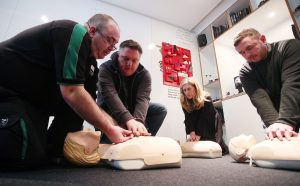3.3.2 Critical Health Events and Bodily Injury
All emergency protocol is dictated by the policies and procedures of the facility where the emergency takes place. When you are a professional care provider working in a client’s home, you should follow the rules of the agency that employs you.
In all emergency situations, your first priority is to ensure your safety, the client’s safety and others’ safety. Then, you must notify the responsible supervisor.
In some cases of critical health events or bodily injury, emergency medical services (EMS) must be contacted immediately, and first aid provided while waiting for EMS to arrive. When injuries are not life-threatening or serious, first aid may be sufficient to address the injury. First aid is practiced as per the protocol of your facility or agency.
Key Concept
It is important that you complete your first aid certification with a reputable and accredited agency in your local area so that you are fully equipped to respond to common medical situations when they happen. Remember: when a situation is beyond your abilities to resolve with basic first aid, call emergency medical services immediately.

Below are examples of some situations that may call for emergency measures. Please follow all links or review the information provided to learn about each one. Pay attention to the signs and symptoms to look for, and the appropriate medical response:
- Bumps and Bruises: Bumps and bruises occur after a client’s body makes contact with an object or surface with force. Bruises are discolouration that can indicate bleeding under the surface of the skin, and should be watched for any signs of severe trauma. Bumps indicate swelling. The initial treatment for bumps and bruises is: rest, elevation, compression and ice. However, bumps and bruises should be monitored carefully for signs of more serious issues, including concussion, sprains, and bone breaks.
- Cuts: Cuts and other minor wounds should be treated with appropriate first aid, and healing should be monitored for any warning signs of infection, slow healing, or a more serious injury.
- Fainting: Fainting, a brief loss of consciousness, should be treated with appropriate first aid, and the client should be monitored in case unconsciousness persists longer than a few minutes.
- Falls. In case of a fall, the client/family/visitor should not be moved until assessed by a supervisor. The treatment consists of assessing the client’s status, including pain, a head-to-toe assessment, and mental assessment. Only when the supervisor states the client is able to be moved can you assist them to a sitting position and to stand, if able.
- Head injury: Treat all head injuries seriously, and always check for concussion. If any signs of a concussion are present, seek emergency help. When there are no signs of concussion or a severe head injury, first aid treatment is usually sufficient.
- Cardiac arrest: In cases of cardiac arrest, immediately contact emergency services and begin cardio-pulmonary resuscitation (CPR), unless there is a Do Not Resuscitate order in place (see the Did You Know? box below). You can watch this video for more information, but the best approach is to ensure that you are current on your CPR certification.
- Seizure: When a client has a seizure, your priority is to protect others, yourself and them. Respond with appropriate first aid.
- Shock: After a trauma, it is common for a person’s body to go into shock, which can lead to serious outcomes. It is a good idea to treat for shock as soon as possible by following appropriate first aid advice.
- Choking: Choking can present as a partial obstruction (i.e. the client can still cough) or a full obstruction (i.e. the client cannot cough). Be sure to become familiar with how to respond in both circumstances.
Did You Know?
Many facilities request Do Not Resuscitate (DNR) orders for clients with specific diagnoses. Be aware of the resuscitation orders for each client prior to initiating cardio-pulmonary resuscitation (CPR) or any other life-saving measures when vital signs (e.g., heartbeat or breathing) are absent. If a DNR order is in place, you will not begin any lifesaving measures in the case of cardiac arrest. Instead, ensure that the person is out of sight of the public, check vital signs, and call for your supervisor. Stay with the client until your supervisor arrives.
If you would like more information on taking vital signs, please feel free to watch this optional video.
After the emergency has passed, you will be asked to complete an incident report that documents the events and your responses to them while they are fresh in your mind. Incident reports are important documents that provide evidence in legal cases, data to improve care, and information to help develop or improve policies and protocols. Decision-makers will review incident reports to understand what happened, determine causes and learn from problems to avoid the situation in the future. Incident reports are discussed in more detail in Chapter 4.
Media Attributions
- First aid training for black cab drivers © TaylorHerring is licensed under a CC BY-NC-ND (Attribution NonCommercial NoDerivatives) license

